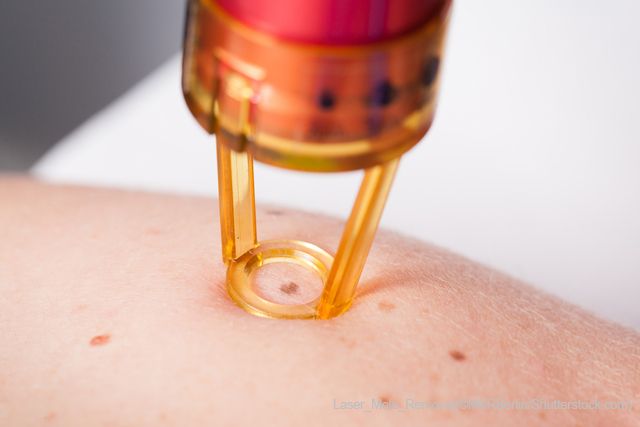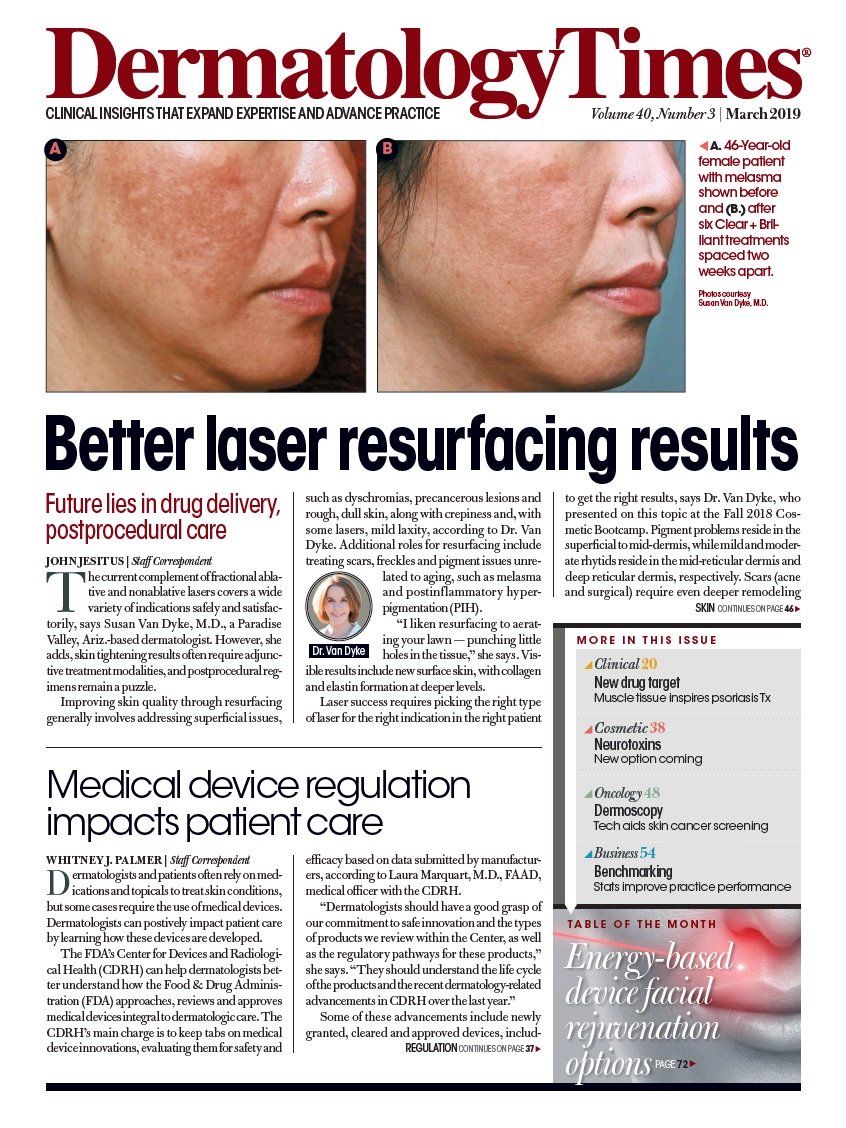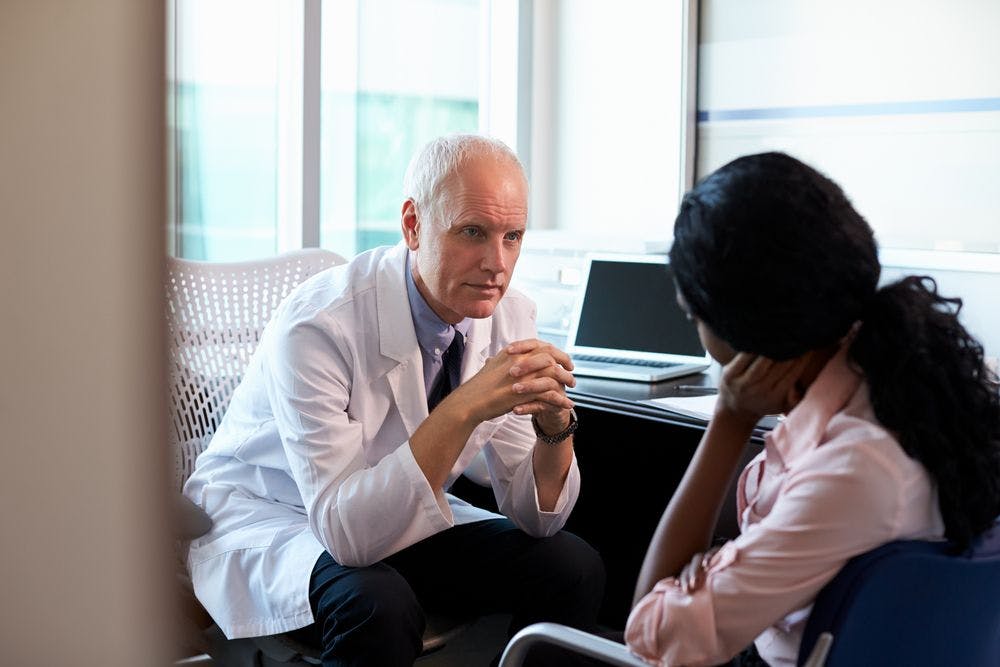- Acne
- Actinic Keratosis
- Aesthetics
- Alopecia
- Atopic Dermatitis
- Buy-and-Bill
- COVID-19
- Case-Based Roundtable
- Chronic Hand Eczema
- Chronic Spontaneous Urticaria
- Drug Watch
- Eczema
- General Dermatology
- Hidradenitis Suppurativa
- Melasma
- NP and PA
- Pediatric Dermatology
- Pigmentary Disorders
- Practice Management
- Precision Medicine and Biologics
- Prurigo Nodularis
- Psoriasis
- Psoriatic Arthritis
- Rare Disease
- Rosacea
- Skin Cancer
- Vitiligo
- Wound Care
Publication
Article
Dermatology Times
Medical device regulation impacts patient care
Author(s):
Laura Marquart, M.D., FAAD, medical officer with the FDA’s Center for Devices and Radiological Health (CDRH), reviewed how the FDA approaches, reviews, and approves medical devices integral to dermatologic care at the American Academy of Dermatology’s annual meeting in Washington, D.C. Learn how this process can affect patient care in this article.
“Dermatologists should have a good grasp of our commitment to safe innovation and the types of products we review within the Center, as well as the regulatory pathways for these products,” Laura Marquart, M.D., FAAD says. (©MKRBerlin/Shutterstock.com)

Dermatologists and patients often rely on medications and topicals to treat skin conditions, but some cases require the use of medical devices. And, knowing more about how these devices are safely developed can positively impact patient care.
To help dermatologists gain a better understanding of how the Food & Drug Administration (FDA) approaches, reviews, and approves medical devices integral to dermatologic care, Laura Marquart, M.D., FAAD, medical officer with the FDA’s Center for Devices and Radiological Health (CDRH), presented on the topic at the American Academy of Dermatology’s annual meeting in Washington, D.C. The CDRH’s main charge, she says, is to keep tabs on medical device innovations, evaluating them for safety and efficacy based on data submitted by manufacturers.
“Dermatologists should have a good grasp of our commitment to safe innovation and the types of products we review within the Center, as well as the regulatory pathways for these products,” she says. “They should understand the lifecycle of the products and the recent dermatology-related advancements in CDRH over the last year.”
For example, she touched on newly granted, cleared, and approved devices, including dermal fillers and micro-needling devices. There has also been recent growth in point-of-care diagnostics, ablative technologies, skin-imaging devices, lasers, and wound dressings.
In addition, Marquart discussed the current re-organization underway at the CDRH. These efforts are designed to help increase information sharing across the center, as well as inform collective decision-making. Once complete, she says, the re-organization will greatly benefit the quality of services patients receive.
“As we re-organize, it will allow us to work more efficiently and engage colleagues across offices in the CDRH, the agency, and the medical community,” she says. “This will, ultimately, benefit patient care.”
WHAT DERMATOLOGISTS SHOULD KNOW
One of the most significant things dermatologists should understand about the CDRH, Marquart says, is how it oversees and approves Class III devices, the products that present the highest level of risk to patients. These devices also require pre-market approval (PMA) and must follow a specific application process.
According to Marquart’s presentation, there are six ways new or modified Class III devices can apply for PMA.
- New device: These products must submit an original PMA with manufacturer-provided clinical and pre-clinical data. This application also applies to significant changes to existing product design or patient populations for which new data would be necessary.
- Panel-track PMA supplement: This application applies to significant device design or performance changes, as well as new indications for use. New clinical data is necessary.
- PMA (180d) supplement: Devices that have significant changes in components, materials, design, specifications, software, color additives, or labeling should pursue this application.
- PMA Real-Time supplement: Products, for which the FDA has previously determined the real-time supplement is appropriate, should apply. It covers minor changes to device design, software, sterilization, or labeling.
- Special PMA supplement: This application covers device changes to labeling, quality control, and manufacturing processes that enhance device safety or use.
- PMA 30-day notice: This application applies to changes in the manufacturing process or manufacturing method.
DERMATOLOGY EXAMPLES
These examples were offered to give providers a better idea of which dermatological devices fall into PMA categories.
- Panel-track PMA: Expansion of diabetic foot ulcer care, including wound dressing approved for use on burn wounds and scars would fall into this category. This application would require new clinical data.
- 180-d supplement: Cannula administration added to labeling for a dermal filler approved for needle administration would be part of this group. It would need confirmatory clinical and pre-clinical data and manufacturing validation.
- Real-time supplement: A change to the material of a syringe plunger on an approved syringe for approved dermal fillers would need this type of application. New pre-clinical data would be required.
- 30-d notice: The change to manufacturing equipment for filling syringes for an approved dermal filler would require this type of PMA. New pre-clinical data and manufacturing validation would be needed.
WHAT DERMATOLOGISTS CAN DO
A dermatologist’s role with medical devices can go beyond clinical implementation, Marquart says. In fact, there are several ways a provider can impact medical device quality and safety.
First, interested dermatologists can apply to serve on an FDA Advisory Committee or opt to participate in a Network of Experts through a professional society.
Second, when a serious problem arises with a medical device, she says, dermatologists should report it directly to the agency. Doing so helps ensure the FDA can act promptly when it deems any action is necessary.
Third, dermatologists can also collaborate with the FDA in the development of patient or device registries, as well as the development of NEST, the National Evaluation System for Health Technology. NEST uses data collected from clinical registries, electronic health records, and billing claims to generate evidence for device evaluation. Dermatologists can have a positive impact, for example, by augmenting the growth of registries focused on aesthetic devices or wound care. Dermatologists who would like to pursue this type of involvement, Marquart says, should contact cdrhclinicalevidence@fda.hhs.gov.
Overall, she says, she hopes dermatologists will gain a deeper and broader understanding of what the CDRH does and how it impacts dermatological care.
“This presentation should give the provider a better understanding of how CDRH reviews medical devices, the types of devices we review, and several newly cleared or approved devices,” Marquart says.

Newsletter
Like what you’re reading? Subscribe to Dermatology Times for weekly updates on therapies, innovations, and real-world practice tips.




























